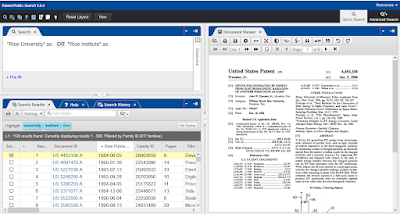I’ve continued to look into the mystery surrounding the date of Rice’s first patent. Last week, I matched the development of Rice’s intellectual property policies to the sudden increases in patents granted (observed in the linked post). The university’s first published policy in 1990 parallels the reappearance of Rice-owned patents that same year; the 1999 policy update similarly parallels the sudden increase in 2000. Most likely, the policy revisions and patent applications were in progress roughly simultaneously, so it is difficult to guess how, or if, they influenced each other. I assume that changes in Rice’s attitude towards IP were behind both policy changes and renewed interest in patents.
I found (in a non-exhaustive search or scientific process) that other American universities and colleges of a similar caliber obtained patents much earlier. My fairly brief search of patent assignees showed that, of the 12 schools I selected, 11 were granted their first patent in the previous decade:
- 1971: MIT, Georgetown and Duke received their first patent.
- 1972: Stanford followed suit.
- 1975: Vanderbilt and University of Chicago came next.
- 1976: Cornell and Princeton were granted patents.
- 1977: Harvard and Yale finally caught up.
- 1978: Dartmouth was the last Ivy League.
Brown University was the outlier, my search showing their first patent in 1984.
These dates may not be completely accurate. To find them, I ran a simple search of assignee names in the USPTO’s Patent Public Search, and arranged results in ascending date order to determine the year of first patents granted. Any possible errors aside, this is probably a moderately representative snapshot of when other top American universities started to officially take interest in patenting their IP.
I am still inclined to think Rice was behind the curve. Even though the above dates indicate that some schools waited longer after their establishment to apply for a patent, they nonetheless show an earlier adoption of modern IP strategies and policies.
So far, no one has explained the timing of Rice’s first patent or the hiatus in patent pursuit. If anyone knows why, or a person who might be able to help me understand, please get in touch! In the meantime, there is more information to find in Rice's records.
Last, I'd like to highlight Cornell’s first patent, which I liked best. Among the listed schools’ high-level scientific and engineering patents, Cornell stands out with a patented cheddar cheese aging technique. Read the enzymatic process developed here, which is equally as intellectually impressive yet much easier to appreciate.

